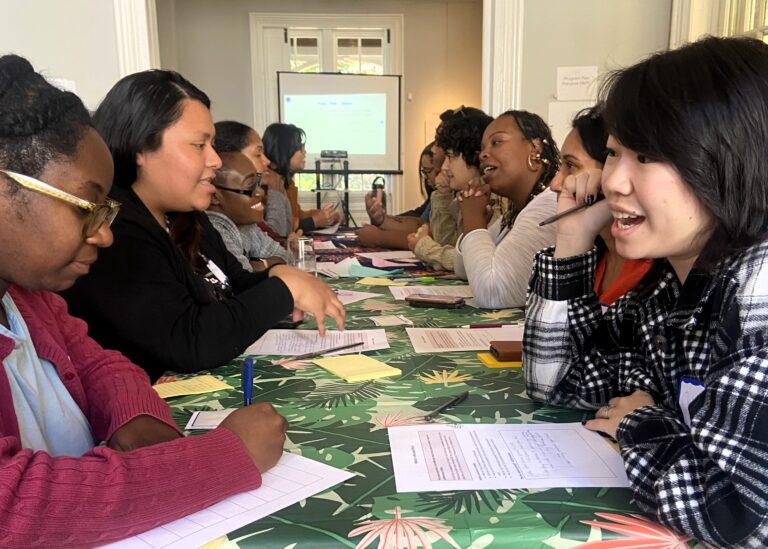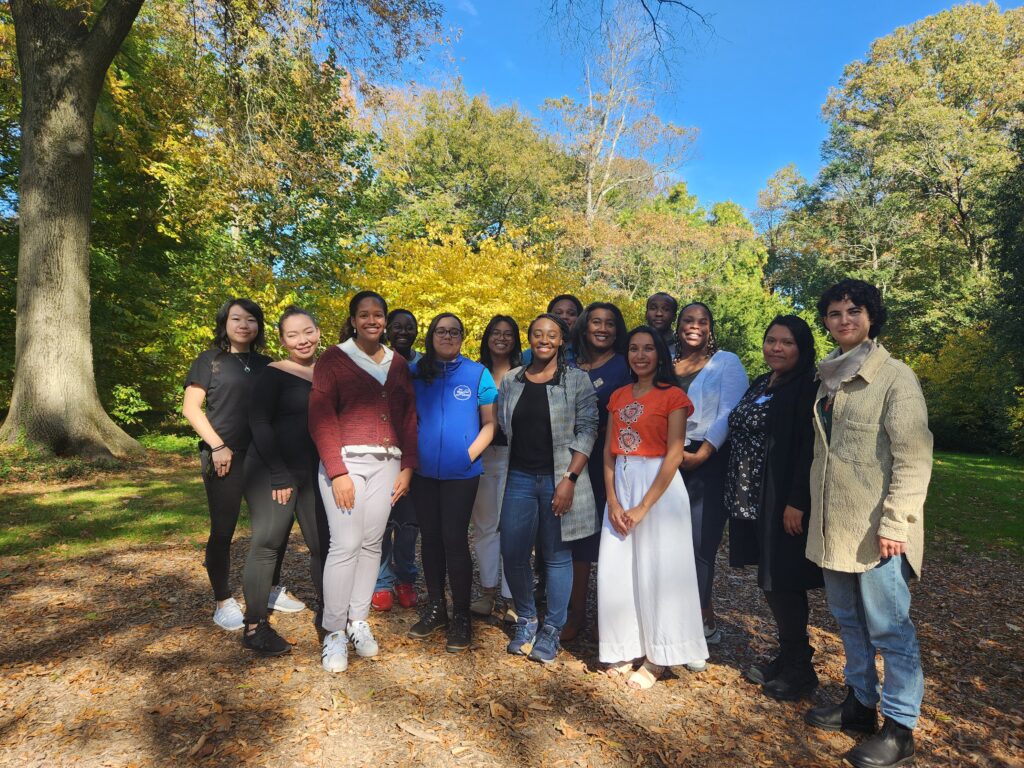
In fall 2022, the Institute for Conservation Leadership (ICL) established a new leadership development program for professionals of color in the Delaware River Watershed region. Born out of ICL’s long-standing role in the Delaware Watershed Initiative, my colleague Pri Ekanayake and I created a program to meet what we saw was an unmet need – to create community and development opportunities for professionals of color in the watershed. With this in mind, we set out to create a program that would provide opportunities for professional development, network building, and skills development. But we wanted to go further than the traditional career development program. So, with a desire to do something different, we set out to create a program with a heavy strengths and asset-based approach to career development. And this focus became, and remained, our north star throughout the year.
With a need identified and our focus clear, we set out to create a strengths-forward career development program that was co-designed and co-facilitated with participants. While we initially designed a program for professionals early in their career, we received applications from individuals with a wide range of experience and education levels. From recent graduates in their first environmental educator job out of college, to mid-level managers with doctoral degrees, we received applications from a broad range of candidates. The result was a program where the participants learned from us, we learned from them, and most importantly, they learned from and built relationships with one another. What follows are three tips that helped us create a strengths-based career development program that we hope can support you to create your own career development programming for young professionals of color.

Embrace a strengths approach to professional development
Why strengths? Being a professional in a new field oftentimes comes with uncertainty, especially for young professionals of color who can find themselves in environments with little to no racial and/or ethnic diversity. It’s easy to question, or have others question, if you belong. And professional development programs that start from a place of addressing deficits, while well intended, can unintentionally reinforce a very insidious belief structure. While skill development is a critical component of professional development, many programs neglect building professional confidence and identity as an important outcome.
To combat this issue, we intentionally created a program where we all — participants and leaders alike — shared the stage to show and uncover our strengths, meaningfully contribute to the program, learn from one another, and learn about ourselves. As program facilitators, we introduced frameworks and key concepts during each gathering, but also developed prompts to allow each member to share their particular skills, perspectives and/or questions related to the topic. During any given session, the participants spent more time talking with one another than we spent providing a lesson. This approach created a space where our unique differences and starting points were valuable contributions, not just things that set us apart.
In this measure, our program structure benefited greatly from the background and experiences of its leaders, especially Pri’s, who is a certified coach for Gallup Strengths, also known as Clifton Strengths Finder. This assessment program has many frameworks and lessons regarding a strengths-based approach. We used this knowledge to build in processes, lessons, and activities that identified and made use of all our strengths.
Co-create the program with participants
Context matters when it comes to career and professional development. The challenges faced by individuals, in this case professionals of color, in the workplace can come from a myriad of different sources. Additionally, while all are valuable, perspectives vary greatly between organizers and participants.
As a result, no matter what we think we know, no one can articulate their challenges points and needs better than those experiencing them.
Given this, we sought to include the participants in co-designing their program.
NY Times columnist David Brooks says the best way to foster connections with others is to “make them authors, not witnesses” of an experience. To that end, we devoted time in the first meeting to sharing the overall design of the program and letting them fill in details about specifics. The year-long program comprised three modules, each containing 3-4 lessons we would focus on in monthly sessions. In our first meeting we shared the program’s outline to spark conversation about the participants’ interests. We asked, “What would you like to add to the program? What would you like to see removed?” and we adjusted accordingly. This allowed us to co-create a program that spoke to the challenges and needs articulated by participants, while also covering some of the foundational elements of career development programs.
Use content that promotes “aha” and self-discovery moments
One of the biggest challenges of being a young professional of color in the conservation space is the idea of “difference.” And in many cases, difference can feel, and be, negative. To address this, we balanced typical career development topics like activities with lessons on adversity and resilience in the workplace, designing your career, and building a network among participants. We used frameworks and exercises that we hoped allowed participants to grow and further develop their career identity and plans. We lead lessons and activities that didn’t necessarily have a right answer but allowed participants to learn something about themselves.
“I hadn’t realized that physical traits such as how the office space is physically organized or what objects employees have at their desks (pictures, cultural artifacts, school affiliations, etc.) play a role. When thinking about workplace dynamics, an organization’s structural traits also never occurred to me as a factor.”
– Malcolm Bundy, participant
It was our hope that these types of self-discovery moments allowed participants to become confident authors of their own stories of career plans and success.
And finally, let them lead
In planning for our final meeting, an all-day, in-person retreat, we revisited the co-creating process. As we did at the beginning of the program, we dedicated one of our last sessions to sharing and deciding on the agenda for our final in-person gathering. However, we then took this one step further by inviting participants to select the topic they were interested in leading and then having them work together in teams to design the session.
The result was a retreat facilitated almost entirely by program participants. From an opening interactive ice breaker, to rounds of speed interviewing, the participants stepped fully into the role of leaders and facilitators. Participants shared their existing and/or newly developed skills, opened new avenues for learning and connections, and established opportunities to stay in community beyond the end of the program. The program firmly became theirs, and we, the program facilitators, stepped into the role of participants.
In closing, I’d like to share another quote from one of our participants, Malcom Bundy, as their perspectives and words are more important than my own.
“It’s hard to believe that it’s been a year since I first joined this cohort. When I first joined, I was incredibly nervous about participating in such a program. However, thanks to the support from my colleagues and other cohort members, I’m thankful that I had the opportunity to participate in this fantastic program. The skills and knowledge I’ve gained throughout this program will be an invaluable resource for me as I navigate my professional career.”
You can read Malcolm’s complete reflection here: https://ttfwatershed.org/2023/11/20/bipoc-cohort-an-invaluable-resource/

2 thoughts on “Want to Help BIPOC Leaders Grow? Build on Their Strengths and Let Them Lead the Way”
She:kon Sewakwekon – Greetings Everyone
Let me first congratulate you on the creation of an exciting program and innovative approach to recognizing and honouring leadership especially in this critical and highly valued field of research and practice. I would also like to add that while reading this I was struck by the lack of recognition for the rich and diverse sharing of cultural knowledge of the participants. Maybe this was something that was an underlying foundation, but it seems to me that without adding the perspective and practice of AI (Ancestral Intelligence), that we’re still doomed to only seeing and interacting using one dominant way of seeing the world. A perspective that has largely gotten us into the mess we’re all currently in. I’m sure that you share the perspective that trying to solve conservation/ecological/environmental problems using the same thinking that got us into this won’t work unless we change our values to inform our behaviours. One of our great teachers Chief Oren Lyons, from the Onondaga Nation, speaks of this from his long perspective working on UNDRIP (The United Nations Declaration on the Rights of Indigenous Peoples) where he shares his thoughts on “Value Change for Survival” that may benefit the work of the Institute.
So happy, am I, to see this valuable work going forward and the steps you’re working to create will be an important legacy pathway forward for environmental change for generations to come.
Best of luck, stay strong and keep up the Great Work!
Onenki wahi
Dr. Dan Roronhiakewen Longboat
Trent University
Thank you for your thoughtful and insightful comment and support of our Professionals of Color program. We are always looking for new perspectives and insights into to how it can be improved and inclusive of more voices and perspectives. The insights you’ve share are invaluable and quite timely as we are preparing to launch our second cohort. You are correct that ancestral perspectives and knowledge are lacking and we share your assertion that their inclusion would strengthen the program.
To that end, we will refence the materials you’ve mentioned above and may also reach out if we have questions. Thank you again for the time you spend not only reading, but composing such a rich response. Please stay in touch.
Comments are closed.